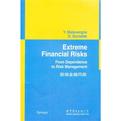极端金融风险
出版时间:2012-10 出版社:世界图书出版公司 作者:(法)马勒沃根 著 页数:312
Tag标签:无
内容概要
In the financial sector, crashes probably represent the most striking eventsamong all possible extreme phenomena, with an impact and frequency thathas been increasing in the last two decades. Consider the worldwidecrash in October 1987 which evaporated more than one thousand billion dol-lars in a few days or the more recent collapse of the internet bubble in whichmore than one-third of the world capitalization of 1999 disappeared afterMarch 2000. Finance and stock markets are based on the fluid convertibilityof stocks into money and vice versa. Thus, to work well, money is requestedto be a reliable standard of value, that is, an effective 8tore of value, hence theconcerns with the negative impacts of inflation.
书籍目录
1 0n the Origin of Risks and Extremes
1.1 The Multidimensional Nature of Risk and Dependence
1.2 How to Rank Risks Coherently?
1.2.1 Coherent Measures of Risks
1.2.2 Consistent Measures of Risks and
Deviation Measures
1.2.3 Examples of Consistent Measures of
Risk
1.3 0rigin of Risk and Dependence
1.3.1 The CAPM View
1.3.2 The Arbitrage Pricing Theory(APT) and the
Fama—French Factor Mode!
1.3.3 The Efficient Market
Hypothesis
1.3.4 Emergence of Dependence Structures
in the Sto'ck Markets
1.3.5 Large Risks in Complex Systems
Appendix
1.A whY Do Higher Moments Allow US to
Assess Larger Risks7
2 Marginal Distributions of Returns
2.1 Motivations
2.2 A Brief History of Return Distributions
2.2.1 The Gaussian Paradigm
2.2.2 Mechanisms for Power Laws in
Finance
2.2.3 EmpiricalSearch for Power Law Tails
and Possible Alternatives
2.3 Constraints from Extreme ValHe Theory
2.3.1 Main Theoretica!Results on Extreme
Value Theory
2.3.2 Estimation of the Form Parameter and
Slow Convergence to Limit Generalized Extreme Value (GEV)and
Generalized Pareto(GPD)Distributions.
3 Notions of Copulas
4 Measures of Dependences
5 Description of Financial Dependences With Copulas
6 Measuring Extreme Dependences
7 Summary and Outlook
References
Index
章节摘录
1.3.5 Large Risks in Complex Systems These calculations show that an endogenous small positive correlation betweenall stock-pairs gives rise to large eigenvalues which can then be associated with "market factors." It seems that earlier researches have promoted the other wayaround: existing market factors (stock indices, news agencies, etc.) introduceexogenous market impact which affect different stocks similarly, thereby in-troducing positive correlation and thus large eigenvalues. This is clear fromthe general formulation of (linear) factor models such as the CAPM, APT,and Fama-French approaches in which the returns of all stocks are regressedagainst the same set of factors. Actually, we propose that the two chains ofcause and result may be intrinsically coupled: the correlation structure be-tween stocks is a stable attractor of a self-organized dynamics with positiveand negative feedbacks in which factors exist because correlations exist, andcorrelations exist because factors exist. It would suggest the development ofdynamical factor models, in wluch agents form anticipations on correlationsbased on their calibration of the past behavior of the regression to factors,in order to study the possible types of attractors (single or multiple equilib-ria) in the correlation structure of stocks. This may cast new light on themajor unsolved problem stated in the introduction of this chapter concerningthe relationship between return and risks: perhaps, the concept of return asthe remuneration of risk which is so fundamental in financial theory shouldbe replaced by the concept of the emergence of the risk-return duality, inwhich their relationship can be negative or positive, depending upon circum-stances that remain to be worked out. Moreover, simulations of complex self-organizing systems show that large fluctuations and extreme variations arethe rule rather than the exception. The complex system approach, which involves seeing interconnections andrelationships, /.e., the whole picture as well as the component parts, is nowa-days pervasive in modern control of engineering devices and business manage-ment. A central property of a complex system is the possible occurrence ofcoherent large-scale collective behaviors with a very rich structure, resultingfrom the repeated non-linear interactions among its constituents: the wholeturns out to be much more than the sum of its parts. Most complex systemsaround us do exhibit rare and sudden transitions that occur over time in-tervals that are short compared with the characteristic time scales of theirposterior evolution. Such extreme events express more than anything else theunderlying forces usually hidden by almost perfect balance and thus pro-vide the potential for a better scientific understanding of complex systems.These crises have fundamental societal impacts and range from large nat-ural catastrophes, catastrophic events of environmental degradation, to thefailure of engineering structures, crashes in the stock market, social unrestleading to large-scale strikes and upheaval, economic drawdowns on nationaland global scales, regional power blackouts, traffic gridlocks, diseases and epi-demics, etc. An outstanding scientific question is how such large-scale patternsof catastrophic nature might evolve from a series ofinteractions on the small-est and increasingly larger scales. In complex systems, it has been found thatthe organization of spatial and temporal correlations do not stem, in general,from a nucleation phase diffusing across the system. It results rather from aprogressive and more global cooperative process occurring over the whole sys-tem by repetitive interactions, which is partially described by the distributedcorrelations at the origin of a large eigenvalue as described above. An instancewould be the many occurrences of simultaneous scientific and technical discov-eries signaling the global nature of the maturing process. Recent developmentssuggest that non-traditional approaches, based on the concepts and methodsof statistical and nonlinear physics coupled with ideas and tools from com-putation intelligence could provide novel methods in complexity to direct thenumerical resolution of more realistic models and the identification of rele-vant signatures of large and extreme risks. To address the challenge posed bythe identification and modeling of such outliers, the available theoretical toolscomprise in particular bifurcation and catastrophe theories, dynamical criticalphenomena and the renormalization group, nonlinear dynamical systems, andthe theory of partially (spontaneously or not) broken symmetries. This fieldof research is presently very active and is expected to advance significantlyour understanding, quantification, and control of risks. ……
图书封面
图书标签Tags
无
评论、评分、阅读与下载
用户评论 (总计1条)
- 较为基础,不失前沿,中
